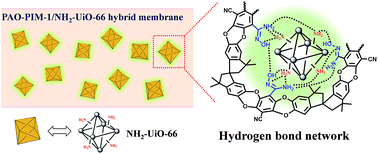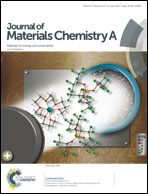Polymers of intrinsic microporosity/metal–organic framework hybrid membranes with improved interfacial interaction for high-performance CO2 separation†
Abstract
Mixed matrix membranes (MMMs), i.e., organic–inorganic hybrid membranes, are one of the most promising membranes for overcoming the performance limitations of conventional polymer membranes in gas separation. Polymers of intrinsic microporosity (PIMs) have received considerable research interest due to their high permeability arising from their rigid and contorted chain structure. However, interfacial issues in PIM-based hybrid membranes are serious due to the low mobility and flexibility of their polymer chains. We present in this work the fabrication of a PIM-based hybrid membrane using amidoxime-functionalized PIM-1 as the polymer matrix and an amine-functionalized metal–organic framework (MOF), NH2-UiO-66, as the inorganic filler. In the hybrid membrane, amidoxime and amine groups tend to form hydrogen bonds, creating a hydrogen bond network between the two phases. Therefore, a nearly ideal and defect-free interface is constructed. The well-designed hybrid membrane exhibits excellent separation performance, especially for CO2 capture, with a CO2 permeability as high as 8425 barrer and CO2/N2 and CO2/CH4 gas pair selectivities of up to 27.5 and 23.0, respectively. The overall separation performance of the hybrid membrane for CO2/N2 and CO2/CH4 surpasses the 2008-updated Robeson upper bound and is outstanding compared with those of existing mixed matrix membranes.



 Please wait while we load your content...
Please wait while we load your content...